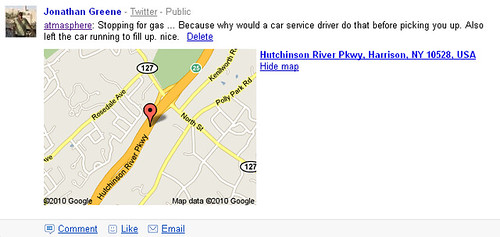In the past few years, I feel like I’ve tried just about every location service. Some have certainly offered more than others, but one thing has been sadly consistent and that’s absolutely no consistency in access to your data. If 2010 can bring one thing, I hope it’s a simplified and federated view into our location data.
Social location services are a very interesting area. I’ve dabbled across various apps to try and find the magic but have come up short. The potential is there, but because no one service or perhaps suite of tools enables
- the right degree of privacy control
- proactive friend notifications
- base of users and importantly a way to contact each other either publicly or privately
A quick look back at the list of things I’ve tried in no particular order… Jaiku, Twitter, Latitude, Nokia FriendView, Loopt, Brightkite, waze, Stalqer, dopplr, tripit, fire eagle, Foursquare and Gowalla. Of all these, only Fire Eagle and Dopplr currently talk and a quick check on Fire Eagle tonight revealed I am in Singapore yet I write this from Katonah, NY. Dopplr actually knows that’s where I am but for some reason has not shared this info with FE … not that it matters for now.
There’s a clear issue with all of this. There is no way to share my location data easily across services and situations. Instead I have to explicitly state or open the app I want to use in order to have things update and shared across my social network. Unlike status messages, location is not a subjective thing, it’s actual. You can and should be able to share the degree of accuracy people see and Latitude does this well. Even the two competing check-in services FourSquare and Gowalla do it differently… Foursquare requires and address if you want the place to be used by others while Gowalla places a pin on the map via GPS. I prefer the GPS method personally as I almost never know or want to take the time to find the address to simply check-in. If I fire Latitude up my location will be highlighted within a few moments, but that’s not something I can actually use.
Speaking of using … the three points I was initially making all clearly tie together.
- I need to have total control over how my location information is shared. I rarely want to show when I am in my home, but showing the town is cool.
- With friends in the system, I want to know when they are close and see that as prioritized info in whatever view I’ve got within the app. For some reason this is not the case with anything. Latitude sorts randomly when you browse the map, Foursquare sorts by time and Foursquare, Gowalla and Stalqer give me updates on everyone regardless of where they are. While there are some modifiable settings, it’s not even close to granular enough to be valuable in this context.
- Having friends in the system is important and since this space is still fragmented there are too many options to choose from to find your friends. Stalqer did an admirable job linking through Facebook, but Facebook doesn’t actually have a native location system.
Twitter and Facebook will probably duke this out in the end with some competition from Google. Currently twitter supports location and you can geo-tag tweets via various mobile clients, but this information is so hidden from the main view, it’s essentially a waste to even bother. Google has quite a few pieces behind the scenes, but so far has not taken them anywhere. You’ll notice I’ve got a location widget on the sidebar of my blog which will show city-level views via Latitude. Other than that Latitude is mainly a view only layer on Maps.
I’m sure 2010 will be a hype filled year for location services. I’m really hoping we’ll see standards that will let these things work together. I don’t want to entrust my location data to a single provider (yet) though if someone was able to develop the right open federation model it would make things very interesting.


